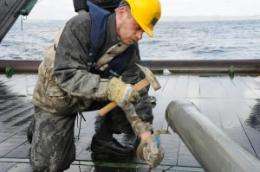Hans Røy. Image from his page at pure.au.dk
(Phys.org) -- A new study by scientists from Denmark and Germany has found live bacteria trapped in red clay deposited on the ocean floor some 86 million years ago. The bacteria use miniscule amounts of oxygen and move only extremely slowly.
Researchers led by Hans Røy from the Center for Geomicrobiology at Aarhus University in Denmark, extracted samples from columns of sediment up to around 30 meters beneath the sea floor in the region of rotating currents north of Hawaii known as the North Pacific Gyre. The sediment columns, built up by deposition of clay, dead algae and crustaceans, and dust, can be as much as several kilometres thick, with the most ancient sediment at the bottom of the columns.
The team used sensitive oxygen sensors to measure the oxygen concentration in the sediment cores. Knowing how much oxygen should have been present at each level allowed them to determine if oxygen was “missing,” which meant it had been consumed by microbes. In most regions of seabed examined previously, all the oxygen is consumed within the first 10 cm of sediment.
They discovered that bacteria within the clay were slowly using the oxygen, and remained alive even at a depth of around 30 meters, even though they have not had access to fresh organic matter for millions of years.
Oxygen respiration rates at the sediment-water interface were 10 μM per liter of sediment per year, and dropped to 0.001 μM at 30 meters, where the sediments were estimated to be 86 million years old. Cellular respiration rates also decreased with depth but stabilized at 0.001 femtomoles of oxygen per cell per day at 1.10 meters beneath the sea floor. (A femtomole is a billionth of a millionth of a mole.) Røy said the team had “no clue” how the microbes were able to subsist on so little oxygen.
Dr. Røy’s team estimated the turnover of the bacterial biomass would take from a few hundred to a few thousand years, but the turnover could represent cell repair rather than cell division. The bacteria may be operating on the absolute minimum energy requirement, which is just sufficient to keep their DNA and enzymes working, and to maintain an electric potential across their cell membranes.
The activity of the bacteria is so slow that Røy likened it to staring at a tree to watch it grow taller, and said the team did not know if the bacteria were reproducing, or if they were the same bacteria that had been deposited in the sediment and were “just not dying.” He estimated they must be at least 1000 years old, but could be much older. They have no contact with sunlight or the surface.
Røy said that an estimated 90 percent of the Earth’s microbial life may exist under the sea floor, but studying them was difficult because the methods have been developed in studying bacteria with rapid life-cycles.
Dr Røy said similar life forms could exist on other planets; if microbial life had ever existed, they could remain alive even if cut off from the surface for millions of years. He also said it gave him a greater appreciation of life on Earth, that you can store clay on the bottom of the sea for 86 million years and find that “somebody’s still living in it.”
More information: Aerobic Microbial Respiration in 86-Million-Year-Old Deep-Sea Red Clay, Science 18 May 2012: Vol. 336 no. 6083 pp. 922-925. DOI: 10.1126/science.1219424
ABSTRACT
Microbial communities can subsist at depth in marine sediments without fresh supply of organic matter for millions of years. At threshold sedimentation rates of 1 millimeter per 1000 years, the low rates of microbial community metabolism in the North Pacific Gyre allow sediments to remain oxygenated tens of meters below the sea floor. We found that the oxygen respiration rates dropped from 10 micromoles of O2 liter−1 year−1 near the sediment-water interface to 0.001 micromoles of O2 liter−1 year−1 at 30-meter depth within 86 million-year-old sediment. The cell-specific respiration rate decreased with depth but stabilized at around 10−3 femtomoles of O2 cell−1 day−1 10 meters below the seafloor. This result indicated that the community size is controlled by the rate of carbon oxidation and thereby by the low available energy flux.
Journal information: Science
© 2012 Phys.Org



















